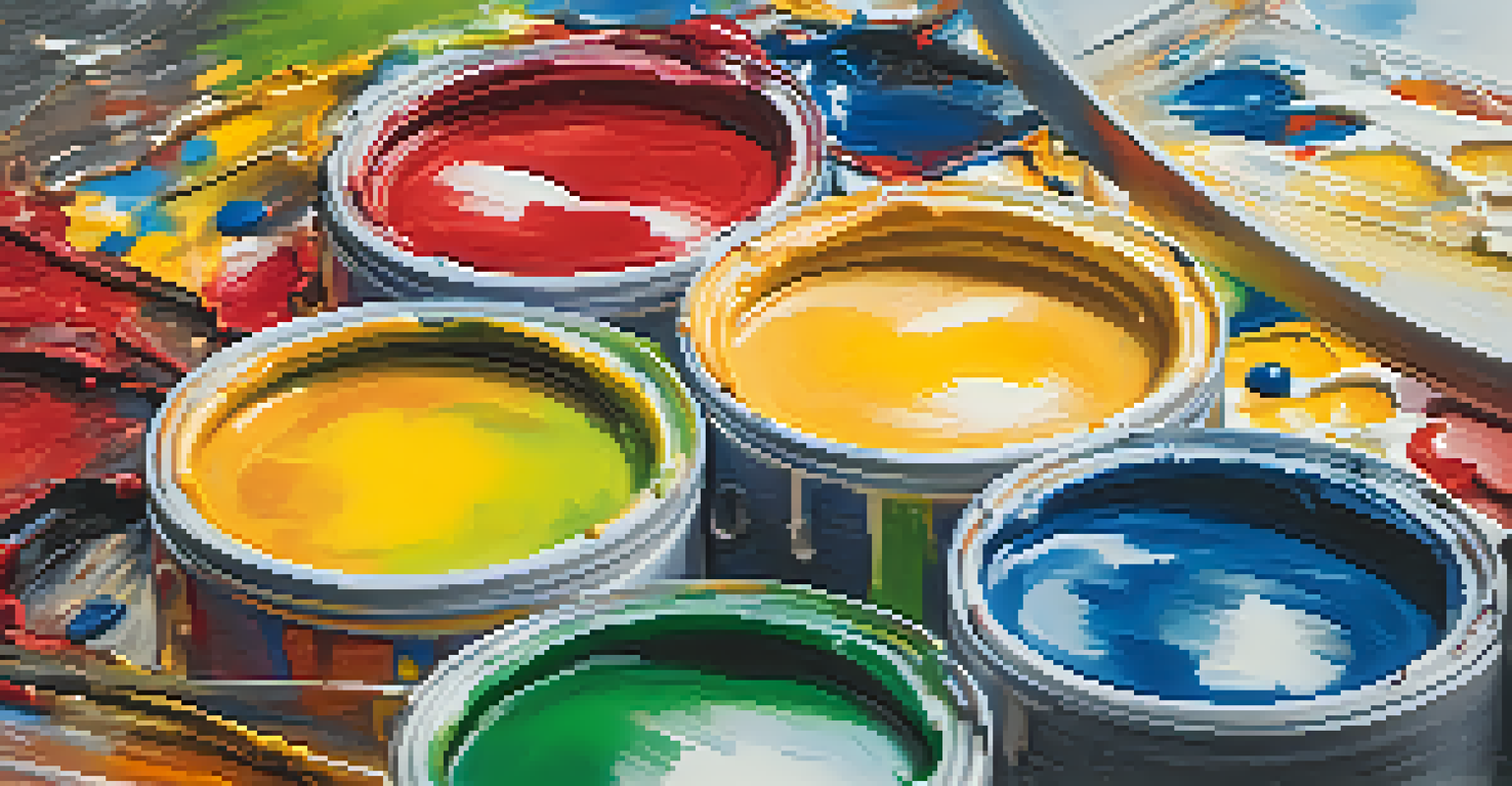The Use of Color Theory in Art: Cultural Perspectives Explored

Understanding the Basics of Color Theory
Color theory is the foundation of art, guiding how colors interact and evoke emotions. It comprises three primary components: hue, saturation, and brightness. By understanding these elements, artists can create more engaging and impactful works. For instance, a vibrant red can evoke passion, while a soft blue might convey calmness.
Color is the keyboard, the eyes are the harmonies, the soul is the piano with many strings.
The color wheel, a key tool in color theory, illustrates the relationships between colors and helps artists choose harmonious palettes. Artists often use complementary colors—those opposite each other on the wheel—to create dynamic contrasts. This foundational knowledge allows for creative expression that resonates with viewers.
Moreover, color theory isn't just about aesthetics; it's deeply intertwined with cultural significance. Different cultures ascribe various meanings to colors, influencing how they are used in art. Recognizing these connections enriches our understanding of artwork across different traditions.
The Cultural Significance of Colors
Colors carry unique meanings that vary greatly across cultures. For example, in Western cultures, white is often associated with purity and weddings, while in some Eastern cultures, it symbolizes mourning and loss. This cultural lens shapes how artists choose to use color in their work, reflecting societal values and beliefs.

In India, the vibrant color saffron is not just aesthetically pleasing; it holds spiritual significance, representing purity and sacrifice. Similarly, in African art, colors often relate to tribal identities and ancestral heritage. These examples illustrate how color becomes a powerful medium for storytelling within cultural contexts.
Color Theory Basics Explained
Understanding hue, saturation, and brightness helps artists create impactful and engaging works.
Understanding these associations can deepen our appreciation of art. When we view a piece through the lens of its cultural background, we unlock layers of meaning that might otherwise go unnoticed. This perspective invites us to engage with art on a more personal and profound level.
Color Symbolism in Western Art
In Western art, colors have historically been infused with symbolism that reflects societal changes. For instance, during the Renaissance, the use of gold symbolized divinity and wealth, often seen in religious paintings. As time progressed, artists began to experiment with color to convey emotions, leading to the impressionist movement's vibrant palettes.
Colors, like features, follow the changes of the emotions.
The modern era brought new interpretations; for example, the color blue became synonymous with melancholy in the works of artists like Picasso. This shift illustrates how color not only defines aesthetic choices but also communicates complex human emotions. It shows how deeply intertwined color is with historical context.
By analyzing color symbolism in Western art, we can trace the evolution of cultural narratives. Each hue tells a story of its time, reflecting the values and struggles of society. This understanding enriches our experience as we engage with art from this tradition.
Color in Eastern Art Traditions
Eastern art traditions often employ color in ways that reflect spiritual and philosophical beliefs. In Chinese culture, for example, red is a symbol of good fortune and joy, frequently used in celebrations and festivals. Artists harness these cultural meanings to create works that resonate deeply with their audience.
Similarly, in Japanese art, colors are often tied to the seasons and nature, reflecting the philosophy of 'mono no aware,' or the beauty of transient moments. Cherry blossoms, depicted in soft pinks, convey the fleeting nature of life. This connection between color and nature enhances the depth and emotive power of Eastern artworks.
Cultural Meanings of Colors
Colors carry unique cultural significance, influencing how artists express societal values and beliefs.
Thus, color in Eastern art is not just about visual appeal; it's a language that conveys profound meanings. By understanding these cultural perspectives, we gain insight into the artist's intent and the cultural narratives woven into their works.
The Role of Color in Indigenous Art
Indigenous art often utilizes color to express identity, history, and spirituality. For many Indigenous cultures, colors are not just aesthetic choices but are imbued with cultural significance and connection to the land. For instance, earthy tones in Aboriginal art represent the connection to the earth and ancestors.
In Native American art, colors like turquoise and red carry meanings related to nature and the spiritual world. These colors are often used in textiles, pottery, and paintings to convey stories and cultural beliefs. Understanding the symbolism behind these colors allows us to appreciate the rich heritage and narratives within Indigenous art forms.
By exploring the role of color in Indigenous art, we recognize the importance of cultural perspectives in shaping artistic expression. Each piece becomes a reflection of the community's values and traditions, offering a glimpse into their worldview.
Modern Interpretations of Color in Global Art
In contemporary art, color theory continues to evolve, influenced by globalization and cross-cultural exchanges. Artists today draw inspiration from diverse cultural palettes, blending colors in innovative ways that challenge traditional boundaries. This fusion creates a rich tapestry of visual experiences that reflect our interconnected world.
For example, artists from different backgrounds may collaborate, combining Western and Eastern color theories to create unique pieces that resonate with a global audience. This blending of colors not only showcases artistic diversity but also highlights the shared human experience across cultures.
Emotional Impact of Color
The use of color in art evokes powerful emotions, guiding viewers' experiences and connections.
As we explore modern interpretations of color, we see how art becomes a dialogue among cultures. This dynamic interaction emphasizes the importance of inclusivity in artistic expression, inviting everyone to find their own meanings within the vibrant spectrum of colors.
The Emotional Impact of Color in Art
Color has a profound emotional impact, influencing how we feel when we engage with art. Artists use warm colors like red and yellow to evoke feelings of warmth and happiness, while cooler colors such as blue and green can instill calm and tranquility. This emotional response is often intentional, guiding viewers' experiences.
For instance, the use of stark contrasts in color can create tension, making the viewer feel uneasy or alert. Artists like Edvard Munch used color to convey emotional turmoil, as seen in his iconic piece, 'The Scream.' This shows how color can serve as a powerful tool for emotional storytelling.

By understanding the emotional impact of color, we enhance our ability to connect with art on a deeper level. It encourages us to reflect on our feelings and experiences, making art not just a visual encounter but a profoundly personal journey.